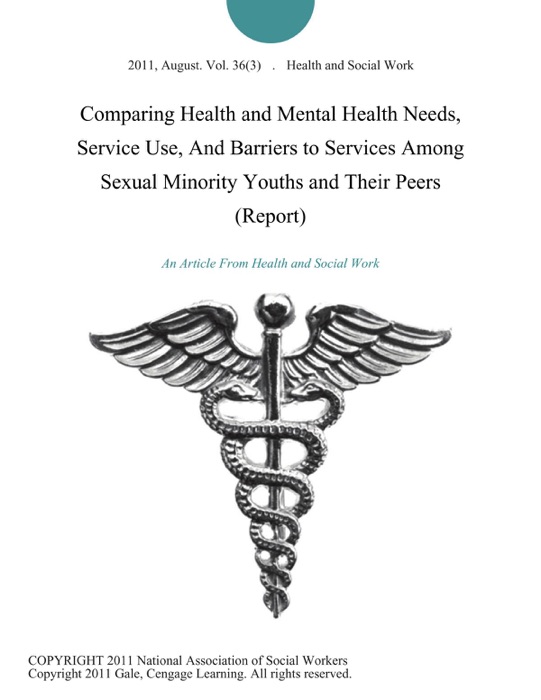[Download] ~ Comparing Health and Mental Health Needs, Service Use, And Barriers to Services Among Sexual Minority Youths and Their Peers (Report) ~ by Health and Social Work ~ eBook PDF Kindle ePub Free

eBook details
- Title: Comparing Health and Mental Health Needs, Service Use, And Barriers to Services Among Sexual Minority Youths and Their Peers (Report)
- Author : Health and Social Work
- Release Date : January 01, 2011
- Genre: Health & Fitness,Books,Health, Mind & Body,
- Pages : * pages
- Size : 254 KB
Description
Community and population-based studies suggest that sexual minority youths (SMYs) (that is, youths who report same-sex romantic attractions or relationships or who identity as nonheterosexual) may be at higher risk for an array of poor health and mental health outcomes in comparison with their heterosexual peers. Recent studies conducted with population-based samples have provided compelling evidence that sexual minority youths (SMYs) experience victimization (Bontempo & D'Augelli, 2002; Garofalo, Wolf, Kessel, Palfrey, & DuRant, 1998; Russell, Franz, & Driscoll, 2001 ; Russell & Joyner, 2001); use alcohol and other illicit substances (DuRant, Krowchuk, & Sinal, 1998; Faulkner & Cranston, 1998; Russell, 2006; Ziyadeh et al., 2007); engage in sexual risk behaviors (Faulkner & Cranston, 1998; Garofalo et al., 1998; Saewyc, Bearinger, Blum, & Resnick, 1999); become pregnant or father a pregnancy (Saewyc et al., 1999; Saewyc, Pettingell, & Skay, 2004); and experience anxiety, depression, and suicidality (Faulkner & Cranston, 1998; Fergnsson, Horwood, & Beautrais, 1999; Garofalo et al., 1998; Garofalo, Wolf, Wissow, Woods, & Goodman, 1999; Remafedi, French, Story, Resnick, & Blum, 1998; Russell & Joyner, 2001; Udry & Chantala, 2002; Waller, 2005) at higher rates than their peers. Although factors contributing to these risks remain unclear, sexual minorities may be at risk of internalizing negative societal messages and may experience higher levels of stress due to stigma, marginalization, oppression, and having fewer family and community supports (Meyer, 1995, 2003). Adolescents in general often do not access basic health services and are the most likely age group to be uninsured (Klein, Slap, Elster, & Cohn, 1993). However, it is possible that SMYs experience additional barriers to health services due to stigma, marginalization, and discrimination (Mercier & Berger, 1989; Paroski, 1987; Travers & Schneider, 1996). Concerns about privacy and confidentiality may also deter SMYs from discussing their sexuality with health care providers, which could hinder appropriate health screenings and patient education (Allen, Glicken, Beach, & Naylor, 1998; Meckler, Elliott, Kanouse, Beals, & Schuster, 2006; Ryan & Gruskin, 2006). Service need and use among SMYs is poorly understood, partly because of limited large-scale data collection efforts that include sexual minority populations. To date, only one representative study has examined help seeking and service use among SMYs, and it found that SMYs were significantly more likely to use mental health services than were peers (McGuire & Russell, 2007). This study further addresses this knowledge gap by providing a comparative analysis of health/mental health needs, access and barriers to services, and the extent of unmet health/mental health needs between SMYs and their peers. The analysis addresses the following research questions: Relative to their peers, do SMYs